My NSTableView seems to be mirroring all content which draws a String. I have never seen something like this before and hope somebody has a tip on how to solve this Problem. I already looked it up, but couldn't find anything. I also filed a bug report, but apple didn't respond.
First idea, that I have: It must have something to do with the NSTextField and NSPopUpButton being disabled at start. They are only enabled as soon as you click one cell. And when they are enabled the text gets displayed the right way. But I don't want to enable them at start to prevent changing values by accidentally clicking one cell.
My Code seems to be fine and compiled without problems.
The Program is a simple Database Program which takes an own created file type and reads its content. From the content it creates Database, Table, Column and cell objects at runtime to display the database content.
Here is my NSTableView Code:
import Cocoa
class TableContentViewController: NSViewController, NSTableViewDelegate, NSTableViewDataSource {
@IBOutlet weak var tableContent: NSTableView!
var columnDragFrom:Int = -1
override func viewDidLoad() {
super.viewDidLoad()
tableContent.dataSource = self
tableContent.delegate = self
// Do view setup here.
tableContent.backgroundColor = NSColor(named: "darkColor")!
NotificationCenter.default.addObserver(self, selector: #selector(reloadData(_:)), name: .tableUpdated, object: nil)
NotificationCenter.default.addObserver(self, selector: #selector(cellSelection(_:)), name: .cellSelection, object: nil)
tableContent.selectionHighlightStyle = .none
}
@objc func cellSelection(_ notification: Notification) {
if let cell = notification.object as? NSTableCellView {
nxSelectionHandler.currentRow = tableContent.row(for: cell)
nxSelectionHandler.currentColumn = tableContent.column(for: cell)
nxSelectionHandler.highlightCell(sender: tableContent)
}
}
@objc func reloadData(_ notification: Notification) {
setupTable()
tableContent.reloadData()
}
func setupTable() {
tableContent.rowHeight = 30
while(tableContent.tableColumns.count > 0) {
tableContent.removeTableColumn(tableContent.tableColumns.last!)
}
if nxSelectionHandler.currentTable != nil {
for column in (nxSelectionHandler.currentTable?.nxColumns)! {
let newColumn = NSTableColumn(identifier: NSUserInterfaceItemIdentifier(rawValue: column.title))
newColumn.title = column.title
tableContent.addTableColumn(newColumn)
}
}
}
func numberOfRows(in tableView: NSTableView) -> Int {
if nxSelectionHandler.currentTable != nil {
var rowCounts:[Int] = []
for column in (nxSelectionHandler.currentTable?.nxColumns)! {
rowCounts.append(column.nxCells.count)
}
return rowCounts.max()!
}
return 0
}
func tableView(_ tableView: NSTableView, mouseDownInHeaderOf tableColumn: NSTableColumn) {
self.columnDragFrom = tableView.tableColumns.firstIndex(of: tableColumn)!
}
func tableView(_ tableView: NSTableView, didDrag tableColumn: NSTableColumn) {
nxSelectionHandler.currentTable?.nxColumns.swapAt(columnDragFrom, tableView.tableColumns.firstIndex(of: tableColumn)!)
tableView.reloadData()
}
func tableView(_ tableView: NSTableView, viewFor tableColumn: NSTableColumn?, row: Int) -> NSView? {
let column = tableView.tableColumns.firstIndex(of: tableColumn!)
if nxSelectionHandler.currentTable != nil {
let nxCell = nxSelectionHandler.currentTable?.nxColumns[column!].nxCells[row]
switch nxCell! {
case .nxString(let value):
var StringCellView = tableView.makeView(withIdentifier: NSUserInterfaceItemIdentifier(rawValue: "nxString"), owner: self) as? StringCell
if StringCellView == nil {
tableView.register(NSNib(nibNamed: "StringCellNib", bundle: nil), forIdentifier: NSUserInterfaceItemIdentifier(rawValue: "nxString"))
StringCellView = tableView.makeView(withIdentifier: NSUserInterfaceItemIdentifier(rawValue: "nxString"), owner: self) as? StringCell
}
StringCellView?.textField?.stringValue = value
return StringCellView
case .nxCheckbox(let state):
var CheckboxCellView = tableView.makeView(withIdentifier: NSUserInterfaceItemIdentifier(rawValue: "nxCheckbox"), owner: self) as? CheckboxCell
if CheckboxCellView == nil {
tableView.register(NSNib(nibNamed: "CheckboxCellNib", bundle: nil), forIdentifier: NSUserInterfaceItemIdentifier("nxCheckbox"))
CheckboxCellView = tableView.makeView(withIdentifier: NSUserInterfaceItemIdentifier(rawValue: "nxCheckbox"), owner: self) as? CheckboxCell
}
CheckboxCellView?.column = column!
CheckboxCellView?.row = row
CheckboxCellView?.checkbox.state = state
return CheckboxCellView
case .nxSelection(let selection, let options):
var SelectionCellView = tableView.makeView(withIdentifier: NSUserInterfaceItemIdentifier(rawValue: "nxSelection"), owner: self) as? SelectionCell
if SelectionCellView == nil {
tableView.register(NSNib(nibNamed: "SelectionCellNib", bundle: nil), forIdentifier: NSUserInterfaceItemIdentifier(rawValue: "nxSelection"))
SelectionCellView = tableView.makeView(withIdentifier: NSUserInterfaceItemIdentifier(rawValue: "nxSelection"), owner: self) as? SelectionCell
}
SelectionCellView?.column = column!
SelectionCellView?.row = row
for option in options {
SelectionCellView?.selection.addItem(withTitle: option)
}
SelectionCellView?.selection.selectItem(at: selection)
return SelectionCellView
}
}
return nil
}
}
The objects used in the Code are all class types and cells are loaded from Nibs, where the cells all have constraints and are displayed the right way. A Screenshot of the NSTableView displaying the content wrong can be seen below.
Code of one of the custom cells:
import Cocoa
class StringCell: NSTableCellView, NSTextFieldDelegate {
var isSelected: Bool = false {
didSet {
self.needsDisplay = true
}
}
override func draw(_ dirtyRect: NSRect) {
super.draw(dirtyRect)
// Drawing code here.
self.textField?.focusRingType = .none
self.textField?.textColor = NSColor.white
self.textField?.delegate = self
self.wantsLayer = true
self.layer?.borderWidth = 2
self.layer?.cornerRadius = 2
if isSelected {
self.layer?.borderColor = NSColor.systemBlue.cgColor
} else {
self.layer?.borderColor = NSColor.clear.cgColor
self.textField?.isEnabled = false
self.textField?.isEditable = false
}
}
override func mouseDown(with event: NSEvent) {
if self.isSelected {
self.textField?.isEditable = true
self.textField?.isEnabled = true
self.textField?.selectText(self)
} else {
self.isSelected = true
NotificationCenter.default.post(name: .cellSelection, object: self)
}
}
func controlTextDidEndEditing(_ obj: Notification) {
if let textField = obj.object as? NSTextField {
nxSelectionHandler.currentCell = nxCell.nxString(textField.stringValue)
}
}
}
